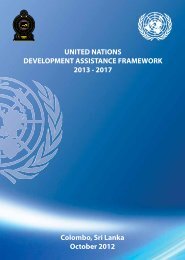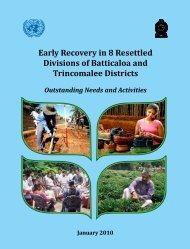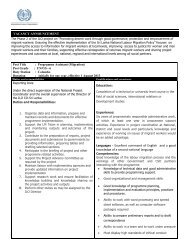Sri Lanka Human Development Report 2012.pdf
Sri Lanka Human Development Report 2012.pdf
Sri Lanka Human Development Report 2012.pdf
You also want an ePaper? Increase the reach of your titles
YUMPU automatically turns print PDFs into web optimized ePapers that Google loves.
The bubble chart (Figure T.3) shows the relationship between<br />
the percentage of multidimensionally poor people and income<br />
poor people. The districts with the highest incidences of<br />
multidimensional poverty and those with highest income<br />
poverty are located in the top right of the chart. Those with the<br />
lowest incidences are located in the bottom left. As there is no<br />
perfect relationship between these two measures, districtsare<br />
not grouped into four distinct clusters. There are overlaps and<br />
gray areas, but broad associations are discernible.<br />
in the chart towards the horizontal axis, Batticaloa District had<br />
the highest incidence of multidimensional poverty, although its<br />
income poverty was less than that for most other districts in its<br />
cluster. Kurunegala had the highest share of people (9.4 percent)<br />
who weremultidimensionally poor, followed by Ratnapura at<br />
8.5 percent, Nuwara Eliya at 7.6 percent, Badulla at 7.5 percent,<br />
Monaragala at 6.6 percent and Kandy at 6 percent.<br />
Figure T.3:<br />
Multidimensionally Poverty and Income Poverty Headcounts by District,<br />
2006-2007<br />
uultiNote: The size of the bubble indicates the share of multidimensionally poor people in eachdistrict<br />
(out of the total in <strong>Sri</strong> <strong>Lanka</strong>); Galle, Matara and Hambantota districts are hidden behind the second<br />
cluster from the bottom.<br />
Source: Computations by the report team of the Institute of Policy Studies of <strong>Sri</strong> <strong>Lanka</strong> using<br />
Department of Census and Statistics of <strong>Sri</strong> <strong>Lanka</strong> 2007a and 2007b.<br />
In 2006-2007, the most deprived districts in the country,<br />
excluding those in the Northern Province, which the survey did<br />
not cover, were Monaragala and Nuwara Eliya, located at the<br />
top right of Figure T.3. They were followed by Matale, Badulla<br />
and Ratnapura, which are located in another cluster just below<br />
the top right. Colombo and Gampaha were the least deprived<br />
districts, followed by Kalutara. In another cluster located midway<br />
Comparison between 2006-2007 and<br />
2009-2010<br />
In <strong>Sri</strong> <strong>Lanka</strong>, health is the most developed of the three HDI<br />
dimensions. Its national index is 0.866, which is considerably<br />
higher than the income index at 0.552 or the educational index<br />
at 0.694. On the other hand, multidimensional poverty analysis<br />
reveals that the health dimension is responsible for 41 percent<br />
Technical Note 175






